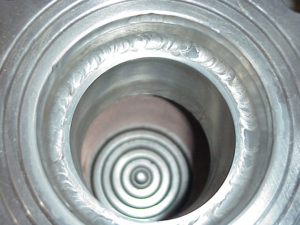

While selecting a heat exchanger, first of all it has to be accurately verified the chemical and physical compatibility between the construction materials and the kind of fluids it will work with. Corrosive and fouling fluids are important factors that will affect not only the performance of the exchanger, but also its longevity and material integrity in the long term. Let’s then go on with some considerations about the viscosity of fluids and their fouling factor.
LOW VISCOSITY FLUIDS (water/water exchangers)
Let’s start with the case where both the fluids involved in the thermal transfer process have a low viscosity, lower than 10 cP: that’s typically the case of water/water thermal exchange. Employing as a cooling media water that comes from natural sources entails even important effects of fouling and corrosion in heat exchangers, due to the presence of suspended particles in water. The most suitable option is then to choose an inspectable plate heat exchanger, which offers the advantage of easy dismantle and cleaning operations. The choice of materials depends on the kind of water, varying from stainless steel alloys, nickel high-alloys or even more nobles such as titanium, and generally all of the metals that can be cold-pressed.
PLATE’S MATERIALS
Stainless steel is somewhat a forced choice because it’s the ‘less noble’ available metal that can be cold pressed and in any case ensures from corrosion and oxidation effects.
It also becomes a forced choice if the plant must be compliant to hygienic standards in the food industry.
The presence of brackish water will instead require more fine materials such as titanium, which approximately doubles the cost of the exchanger compared to stainless steel.
Being equal the thermal capacity, a plate heat exchanger offers the benefit of cutting the costs compared to a tube exchanger, especially considering the long term costs of management. The costs of a copper tube exchanger are equal to a stainless steel plate heat exchanger, but the first one will quickly undergo corrosion, becoming much more expensive in terms of maintenance. Choosing a plate heat exchanger will also allow the freedom to decide for a boosting of the thermal capacity of the thermal machine, simply by adding more plates to the transfer pack, in order to satisfy a changed thermal duty due to different process conditions (increased volume of production, physical variations of the fluids). The addition of further plates will indeed increase the overall thermal transfer surface.
For a proper choice, pressure and temperature limits must also be considered, making sure the kind of fluids is compatible with the construction material of the gaskets and then proceeding with the estimation of a minimum transfer surface required for an efficient thermal transfer, in order to size the correct dimensions of the exchanger.
In case there is scarcity of cooling water coming from a natural source, is then possible to combine this kind of thermal machine with a cooling tower or an air dissipator (the preference depends on a bunch of factors such as meteorological conditions, energy costs, natural or treated water availability), in order to guarantee the recirculation of the water once it has gained the temperature required by the served thermal cycle.
